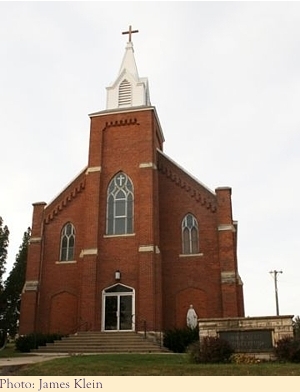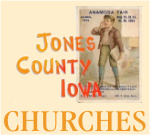 The first two white men who settled on the present site of Monticello, came in the fall of 1836. A few months later—in the summer of '37, two Catholics—James McLaughlin and Thomas Galligan, came and settled in the same region. They were, as far as known, the first Catholics in Jones county. When The Rev. Jeremiah Treacy passed on his circuit through the area, he found out the house of Mr. McLaughlin. He stayed there. He celebrated mass there. The scattered Catholics of that neighborhood assembled and joined in prayer and sacrifice in that improvised domestic chapel. A brother of the itinerant missionary, who sometimes accompanied him, married one of Mr. McLaughlin's daughters thus adding a social tie to the spiritual bond already existing between them.
The first two white men who settled on the present site of Monticello, came in the fall of 1836. A few months later—in the summer of '37, two Catholics—James McLaughlin and Thomas Galligan, came and settled in the same region. They were, as far as known, the first Catholics in Jones county. When The Rev. Jeremiah Treacy passed on his circuit through the area, he found out the house of Mr. McLaughlin. He stayed there. He celebrated mass there. The scattered Catholics of that neighborhood assembled and joined in prayer and sacrifice in that improvised domestic chapel. A brother of the itinerant missionary, who sometimes accompanied him, married one of Mr. McLaughlin's daughters thus adding a social tie to the spiritual bond already existing between them.
Castle Grove is so called from the first house of respectable dimensions built there, by a man named Beardsley, near where the road crosses Silver Creek. Ed. Moore's house stood in the same place in later days. Being the largest, if not the only residence above a log cabin, it was called a "castle" and located as it was in the grove, the township was named from it "Castle Grove."
Among the Catholics, D. M. Hogan and Ed Troy had both been soldiers in the Mexican war. At their discharge they received each a "warrant" entitling them to a "plat" or a quarter section of land, wherever they were pleased to choose, in any part of Uncle Sam's unoccupied domain. At Monticello, getting off the stage, they passed to the western edge of the timber growth, and there they selected a spot which they decided to call home. Here they lived and died. Here too, their children still live. Quarter sections of prairie, adjoining on the west, were taken up in the early 1850s, at government price—one dollar and twenty-five cents an acre—by Dennis Hogan, with his sons, James, Patrick, Michael and Dennis; also by four Kehoe brothers, Ed., Simeon, Patrick and William; by Patrick Waddick, James Delay, and many others further west and north.
As the new settlers spread out over the prairie, the center of population moved further west. The home of Simeon Kehoe, was used as the meeting house for some time. There were no parishes, or parish limits in those days. The priest took with him the necessary outfit for the performance of his official functions, in his saddle-bags if riding, and carried them on his own back if walking. Setting out in search of a Catholic family or settlement, he was free to stop, wherever he people in spiritual need.
The Rev. P. Maginnis, whose headquarters were first at Garryowen, but later at Temple Hill, also made some visitations over this circuit, and received the cordial hospitality of Mr. McLaughan's home.
In 1853, under the leadership of Rev. J. Treacy, a church building was started. The site selected was perhaps the most beautiful in all the township—on the point of a knoll some behind the present pastoral residence. Patrick Mullady donated forty acres of land for the use and benefit of the church in Castle Grove. In the spring of 1854, the church was completed.
The dedication ceremony was scheduled for Father Treacy's periodical visit. The night before the event, the building was burned to the ground by Know Nothings from the western part of the settlement who did not want a Catholic church. The parishioners resolved to rebuild and a second church, which was quite large for those days, was erected during the pastoral attendance of Rev. M. Lynch, who resided in Cascade. He placed the second church of Castle Grove, not on the foundation of the destroyed building, but nearer the road, where the present brick structure stands. His principal employee in the work was a monk from New Melleray called Brother Matthew, (Robert Healy) who later lived for many years at Anamosa, where he died, and is buried in Holy Cross cemetery.
The next succeeding ministerial attendant was Father Cogan. After living for some time in Monticello, he moved to Castle Grove, where he built a parochial house, which still stands as a part of the presbytery which was subsequently enlarged, and later again improved. Father Brennan came next. A sister of his, who kept house for him, died during his pastorate, and lies buried in an unmarked grave behind the church.
Rev. David Walsh followed. He is noted for a famous lawsuit, in which he was prosecuted, by a Bohemian family named Stepanek, of Prairieburg, for damage done to their father's gravestone. District Attorney C. R. Scott strongly prosecuted the hotly contested case, but the result was a hung jury. The late Charles Lull and a Mr. Livingstone from Center Junction, could not be convinced of the Father's guilt. Father Walsh left soon afterward and was dead before the case could be retried. Mr. Scott lost his voice, and resigned.
Castle Grove remained without a pastor for six months until the Rev. Peter O'Dowd was appointed to the charge on the 23rd of September, 1873. There he found the church so lopsided, from the effects of a recent cyclone, that before anyone could even go inside, the walls had to be reinforced. He next found a debt of eight hundred dollars, which exceeded the value of the entire property. Patrick Kehoe, Senior, came forward, and assumed the debt. He then went out and hauled the first load of brick, and having set it down on the ground, he placed on top of it his bond for four hundred dollars in cash for a new building. The foundation of the new church was laid in 1877, and the superstructure erected in the following summer. At the laying of the cornerstone, the sermon was preached by the Rev. L. Roche, then of Davenport, now of Cascade. The dedication took place on September 8, 1880, by Bishop Hennessy of Dubuque.
The report in a local newspaper says of the building: "We have heretofore fully described the gothic solidity of the exterior of this church edifice—than which there is no finer outside of the large cities in the state of Iowa." The writer then devotes much flowery language to the beauty of the interior. The writer concludes: "The people of Castle Grove are the most prosperous community in Jones county, and in the day of their prosperity they have not forgotten to be liberal. The work they have accomplished in the completion of this church speaks volumes for their public spirit, and for the diligence and wisdom of Rev. Father O'Dowd."
For the first six years in Castle Grove, Father O'Dowd attended to the Catholic church in Monticello, driving eight miles between the two places. Besides the magnificent church, this pastor also built a very neat schoolhouse, which was first rented to the directors of the district, and utilized as a public school, but later was converted into a parochial school, with a residence for teachers and boarders attached. At the time of this change it was moved to its present site—behind the church. The grounds were admirably ornamented with rows of evergreen and shade trees, and the cemetery beautifully renovated. Father O'Dowd not only liquidated every penny of debt, but a balance of nine hundred dollars was left in the church treasury when he left.
In September, 1880, the Rev. J. Fogarty succeeded to the pastorship. He remained until October, 1882, when he was replaced by the Rev. R. Powers, who served the people until March, 1886. Then for a few months the duties of pastor were filled by Rev. J. Griffin. After him came Rev. M. S. Murphy, who is the present pastor.






